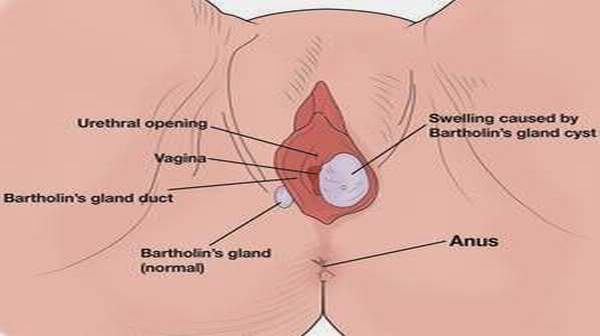The Bartholin’s (BAHR-toe-linz) glands are located on each side of the vaginal opening. These glands secrete fluid that helps lubricate the vagina.
Sometimes the openings of these glands become obstructed, causing fluid to back up into the gland.
The result is relatively painless swelling called a Bartholin’s cyst. At times, the fluid within the cyst may become infected, resulting in pus surrounded by inflamed tissue (abscess).
A Bartholin’s cyst or abscess is common. Treatment of a Bartholin’s cyst depends on the size of the cyst, the pain and whether the cyst is infected.
Sometimes home treatment is all you need. In other cases, surgical drainage of the Bartholin’s cyst is necessary. If an infection occurs, antibiotics may be helpful to treat the infected Bartholin’s cyst.
Causes
Experts believe that the cause of a Bartholin’s cyst is a backup of fluid. Fluid may accumulate when the opening of the gland (duct) becomes obstructed, perhaps by the growth of a flap of skin or because of infection.
A cyst can become infected, forming an abscess. A number of bacteria may cause the infection, including common bacteria, such as Escherichia coli (E. coli), as well as bacteria that cause sexually transmitted infections such as gonorrhea and chlamydia.
Symptoms
Most Bartholin’s cysts do not cause any symptoms. However, you may feel a soft, painless lump in your labia (the two pairs of lips that surround the entrance to your vagina).
You may not know that you have a cyst until it is found during a routine cervical screening test or an examination carried out for another reason.
If the cyst grows very large, it can become uncomfortable and noticeable. You may feel pain in your vulva (external sexual organs) when you walk, sit down or have sex.
Sometimes, the cyst can affect the outer pair of lips around the opening of the vagina (labia majora). One side may look swollen or bigger than usual.
If the cyst or Bartholin’s gland becomes infected, an abscess may develop. This is a painful collection of pus that often gets bigger over a few hours or days.
Signs of an abscess include the affected area becoming red, swollen, tender and hot. An abscess can also cause a high temperature of 38°C (100.4°F) or above.
Treatment
If the cyst is small and presents no symptoms the doctor may recommend no treatment – the patient will be asked to report any growth in the size of the cyst. Any lump in the vulval area should be reported, especially if the patient has started the menopause.
If a small cyst causes discomfort, OTC painkillers, warm baths and/or warm compresses against the affected area may help relieve symptoms. A warm bath may also help the cyst to burst. If an abscess develops, the patient will be prescribed an antibiotic.
The doctor may perform a minor procedure at his/her practice; a catheter is inserted into the cyst and inflated to fix it there. The catheter remains there for 2 to 4 weeks while the fluid is drained and a normal opening is formed.
Marsupialization involves cutting the cyst open and draining the fluid out. The edges of the skin are stitched together while still holding a channel open for the secretions to come through.
Carbon dioxide laser can create an opening so that the cyst is drained.
A needle can be used to drain the cyst (needle aspiration). Sometimes after draining the cyst, the cavity is filled with a 70% alcohol liquid solution for a few minutes before that is drained out.
If the woman has many recurring cysts and does not respond well to any therapies, the doctor may recommend removing the Bartholin’s gland (gland excision).
Prevention
- In a significant number of cases there is not much the woman can do to prevent the occurrence of a Bartholin’s cyst.
- Sexually active people should use a barrier method of contraception, such as a condom.
- Some people say that sitting in a warm bath may help the cyst to burst, thus preventing the formation of an abscess.





